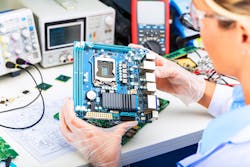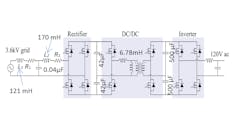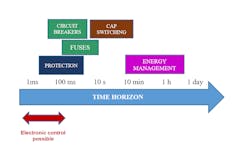Electronic Engineering and Power Distribution Engineering: Do they Mix?
When many of us went to school, there was a split between the power engineers and the electronic engineers. Even the professional societies were separate: IRE and AIEE. But perhaps the science and engineering behind these areas was not always so separated. Some applications were blurred from the 1930s. The distinction is getting less and less evident now. Why? It could be that the electronic engineers are making considerable headway in power ratings and costs. It could be that power engineers are under pressure to control the system to accomplish some socio-political and economic objectives. It could be that the electrons do not know if they are power related or electronics related.
The essence of electronic devices is the use of semiconductor switches for current control. That means the use of a semiconductor switch to interrupt current in such a way as to control power flow by a means that does not involve resistive losses.
In addition to advances in electronic devices, and changes in the power industry, the appearance of the Smart Grid initiative has brought renewed interest in enhancement of all parts of power systems. The ‘distribution system’ refers to the lower voltage system that is energized at the distribution substation, delivering power to loads via a primary distribution system. Traditionally, the primary distribution system has had a radial configuration with many feeders and laterals ‘fanning out’ to loads. The Smart Grid philosophy is to implement the elements of the U.S. Energy Independence and Security Act of 2007. The main objectives are:
- Self-healing in cases of disturbances
- Active participation by consumers (e.g., demand response)
- Operational under physical and cyber attack
- Providing power quality for contemporary loads (for example, sensitive loads)
- Accommodating both traditional and new generation, and storage technologies
- Enabling new markets, products and services
- Efficient operation and optimizing the utilization of system assets.
Why electronic controls?
Focusing on distribution engineering, it appears prudent to look to methods to control power in such a way as to implement the principals of the Smart Grid, and this entails managing power levels through about 10 MVA in distribution primaries, voltages generally in the 15 kV class (but logically extending to the 35 kV class in the not too distant future), and speed of control measured in cycles (for example, 16.7 m/s). At the secondary distribution level, requirements are much less demanding at about 25 kVA and 440 V. In fact, at this secondary distribution level, power electronic devices now are believed to comprise roughly 80% of all loads. There is nonetheless the remaining question as to what hobbles electronic controls present. These are mainly:
- Difficulties in compliance with basic impulse insulation level requirements (BIL, also known as lightning impulse withstand level, LIWL)
- Cost
- Reliability (particularly in view of unfavorable electrical environments)
- Losses in the semiconductor switches.
Perhaps the greatest challenge in electronic asset deployment is matching the voltage, power, and energy limitations of solid state components with the requirements of power engineering applications. As a quick example, Fig. 1 shows a solid state distribution transformer (that is, the conversion from a 3.6 kV distribution primary to a 120 V AC secondary. The solid state switches are insulated gate bipolar transistors (IGBTs). A filter is used at the front end of the device to reject high frequencies due to the IGBT switching, and also to attenuate lightning impulses in the distribution primary.
Electronic devices have come a long way in the last 20 years in terms of ratings, cost, and manufacturability. As an example, insulated gate bipolar transistors (IGBTs) are now available in the 3.3 kV, 250 A range (with multiple packaged devices going well above these levels to perhaps 5 kV or more and 2 kA). Unfortunately, these are not yet at the distribution primary voltage levels individually, but series and parallel connections can accommodate distribution operating voltages. However, series and parallel configurations of devices may result in reliability issues.. There has been a considerable focus of researchers on how to make maximal use of electronic controls while not exceeding the ratings of the electronic switches. For example, the researchers of the Power Systems Engineering Research Center (PSerc) have devoted several two year projects on exactly this objective.
Power electronic controls have the valuable capability of power conditioning. This is the capability to process the voltage waveforms in such a way as to promote power quality in real time. This is a significant advantage of electronic components. Among the power conditioning and power quality capabilities are: voltage regulation, suppression of harmonics, ride through of momentary low voltage conditions, three phase balancing, and power factor correction.
It is interesting to conjecture where power electronic device ratings are going and when will they get there? Part of the answer lies in the use of high voltage semiconductor materials such as Indium Nitride and Silicon Carbide. No one has a firm answer as to projected advances in the next 10 years, but it is reasonable to expect switching devices in the 5 to (perhaps) 20 kV range at 1 kA for a single device. In parallel with this time frame, distribution primary voltages may well reach the 35 kV class in the next 10 years. Keeping in mind that the basic (lightning) impulse insulation level requirements of 60 kV for 15 kV distribution systems, the cited numbers, if accurate, imply that series and parallel connections of semiconductor switches are likely to be with us for at least 10 years.
A related important rating of semiconductor switches is operating speed – basically how fast can these devices switch? Contemporary IGBTs can operate well into the tens of kilohertz range, and the conclusion is that subcycle control is readily available using these devices. Fig. 2 shows a pictorial comparison of some distribution class operating times and how the electronic component speeds compare.
Power and energy losses
It is not unusual to ask about the efficiencies presently available in power distribution systems. The question is not easy to answer because this depends on operating conditions, the point in the system under study (for example, primary distribution or secondary), and the asset proliferation and specific system under study. As an example, in the United States, there are mandated maximum loss levels for distribution system transformers (generally less than 1.5%). In approximate terms, total distribution system losses below 5% are usual, and below about 3% in distribution transformers and primary conductors is usual. Semiconductor switches in the distribution system may result in higher losses with the main reason being that (simplistically) nonzero voltage and current across the semiconductor junction exist simultaneously as the device is switched. This is switching loss. There are, however, strategies that minimize losses such as zero voltage switching.
Reliability and power availability issues
Reliability and availability of electric power from distribution circuits is an essential element of power distribution engineering. Perhaps the most quoted measures of reliability are the System Average Interruption Duration Index (SAIDI) and the System Average Interruption Frequency Index (SAIFI),
Typical U.S. distribution systems exhibit SAIDI in the range of 1.4 to 2.0 hours (per year), and SAIFI about 1.1.
In the digital age, hyper reliability may be required (or aspired?) with very few service interruptions. For example, 99.9% reliability may be viewed as service with ‘three nines’. Let p be the fraction of time that a given load is in service (for example, p = 0.999 for 99.9%). Then the ‘number of nines,’ N9, is defined as,
N9 = -log10(1-p).
Thus, if p = 0.9999, N9 = 4. The role of semiconductors appears in two places with regard to hyper reliability: one role is that digitally controlled loads often have high sensitivity in terms of failures due to momentary outages. The other role is that semiconductor switched distribution circuits have been proposed to dramatically increase service reliability by switching out failed laterals in favor of sound laterals (that is, reconfiguring the distribution system in real time). Thus electronic switches are both a realistic capability and a reason to design for hyper reliability. By comparison, reliability for a power system design quoted as one day in 200 years outage corresponds to 4.9 nines, or the U.S. Federal Aviation Administration requirements for aircraft reliability is specified at 6 to 12 nines.
There is no question that electronic controls in distribution systems are coming — to match their applications in loads. The ‘competition’ to accomplish Smart Grid objectives include: raising the primary distribution voltage to 35 kV; implementing more networked (that is, looped) primary and secondary distribution circuits; increased use of underground distribution; and integration of distributed generation in the system. There are some hybrid configurations that would incorporate some electronic components with conventional components, for example, real time network switching to isolate failed distribution system components and the use of solid state transformers and solid state circuit breakers (for example, solid state fuses).
About the Author
G. T. Heydt
Gerald Thomas Heydt is a retired regents’ professor at Arizona State University, Tempe, AZ and the Power Systems Engineering Research Center. His PhD is from Purdue University (1971). He is a life fellow of the IEEE, and a member of the National Academy of Engineering. He works in the area of transmission and distribution engineering. He has industry experience with the Commonwealth Edison Co., Chicago. In 2010, Dr. Heydt was awarded the IEEE Richard Harold Kaufmann award for contributions to electric power quality and transmission and distribution engineering. He has been active in the Power Systems Engineering Research Center.



